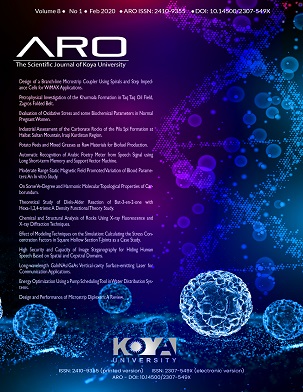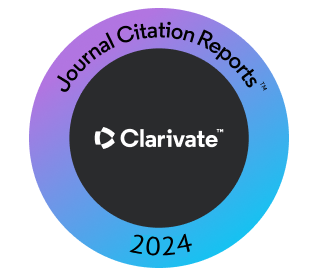Automatic Recognition of Arabic Poetry Meter from Speech Signal using Long Short-term Memory and Support Vector Machine
DOI:
https://doi.org/10.14500/aro.10631Keywords:
Speech processing, Long short-term memory, Support vector machine, Prosody, Cepstral featuresAbstract
The recognition of the poetry meter in spoken lines is a natural language processing application that aims to identify a stressed and unstressed syllabic pattern in a line of a poem. Stateof-the-art studies include few works on the automatic recognition of Arud meters, all of which are text-based models, and none is voice based. Poetry meter recognition is not easy for an ordinary reader, it is very difficult for the listener and it is usually performed manually by experts. This paper proposes a model to detect the poetry meter from a single spoken line (“Bayt”) of an Arabic poem. Data of 230 samples collected from 10 poems of Arabic poetry, including three meters read by two speakers, are used in this work. The work adopts the extraction of linear prediction cepstrum coefficient and Mel frequency cepstral coefficient (MFCC) features, as a time series input to the proposed long short-term memory (LSTM) classifier, in addition to a global feature set that is computed using some statistics of the features across all of the frames to feed the support vector machine (SVM) classifier. The results show that the SVM model achieves the highest accuracy in the speakerdependent approach. It improves results by 3%, as compared to the state-of-the-art studies, whereas for the speaker-independent approach, the MFCC feature using LSTM exceeds the other proposed models.
Downloads
References
Abuata, B. and Al-Omari, A., 2018. A rule-based algorithm for the detection of arud meter in CLASSICAL Arabic poetry. International Arab Journal of Information Technology, 15(4), pp. 1-5.
Al-Falahi, A. Ramdani, M. and Bellafkih, M., 2017, Machine learning for authorship attribution in Arabic poetry. International Journal of Future Computer and Communication, 6(2), p. 486.
Almuhareb, A. Alkharashi, I. Al-Saud, L. and Altuwaijri, H., 2013. Recognition of Classical Arabic Poems. In: 2nd Workshop on Computational Linguistics for Literature, pp. 9-16.
Alnagdawi, M., Rashideh, H. and Aburumman, F., 2013. Finding Arabic poem meter using context free grammar. Journal of Communication and Computer Engineering, 3(1), pp. 52-59.
Araújo, L. 2010, Computer-based Assessment (CBA) of Foreign language speaking skills. JRC Scientific and Technical Reports, 1, p. 165. Arberry, J., 1965. Arabic Poetry. A Primer for Students. Cambridge University Press, Cambridge.
Hirjee, H. and Brown, D., 2010, Using automated rhyme detection to characterize rhyming style in rap music. Empirical Musicology Review, 5(4), pp. 121-145.
Hochreiter, S. and Schmidhuber, J., 1997. Long short-term memory, Neural computation, 9(8), pp. 1735-1780.
Ismail, A., Eladawy, M., Keshk, H. and Saleh, S., 2010. Expert system for testing the harmony of Arabic poetry. Journal of Engineering Sciences, 1, pp. 401-411.
Kurta, A. and Kara, M., 2012. An algorithm for the detection and analysis of Arud meter in Diwan poetry. Turk Journal of Electrical Engineering and Computer Science, 20(6), pp. 948-963.
Lipton, C., Berkowitz, J. and Elkan, C., 2015. A Critical Review of Recurrent Neural Networks for Sequence Learning, arXiv Preprint arXiv: 1506.00019. Available from: https://www.arxiv.org/abs/1506.00019.
Morris, H., 1966. On the metrics of pre-islamic Arabic poetry. Quarterly Progress Report of the Research, Laboratory of Electronics, 83, pp. 113-116.
Rao, K. and Koolagudi, S., 2013, Robust Emotion Recognition using Spectral and Prosodic Features. Springer Science and Business Media. Berlin, Germany, pp. 23-24.
Reynolds, A., 1995. Speaker identification and verification using Gaussian mixture speaker models. Speech Communication, 17(1-2), pp. 91-108. Available from: https://www.sciencedirect.com/science/article/abs/pii/016763939500009D.
Rutledge, J.C., 1995. Fundamentals of speech recognition, by lawrence rabiner and bing-hwang juang. Analysis of Biomedical Engineering, 23, pp. 526-526.
Sarangi, S.K. and Saha, G., 2020, Improved speech-signal based frequency warping scale for cepstral feature in robust speaker verification system. Journal of Signal Processing Systems, 1, pp. 1-14.
Scott, H. 2010. Pegs, Cords, and Ghuls: Meter of Classical Arabic Poetry. Swarthmore College Department of Linguistics. Available from: https://www.scholarship.tricolib.brynmawr.edu/handle/10066/6864.
Sønderby, K., Sønderby, K., Nielsen, H. and Winther, O., 2015. Convolutional LSTM Networks for Subcellular Localization of Proteins. International Conference on Algorithms for Computational Biology, Springer, pp. 68-80.
Stoetzer, W., 1989. Theory and Practice in Arabic Metrics. Leiden, Het Oosters Institute. Vapnik, V., 1995, The Nature of Statistical Learning Theory. Springer-Verlag, NewYork. Available from: https://www.springer.com/gp/book/9780387987804.
Wells, J.R., Ting, K.M. and Naiwala, C.P., 2012, December. A Non-time Series Approach to Vehicle Related Time Series Problems. Vol. 134. In: Proceedings of the 10th Australasian Data Mining Conference, Australian Computer Society, Inc., pp. 61-70.
Yousef, W.A., Ibrahime, O.M., Madbouly, T.M. and Mahmoud, M.A., 2019. Learning meters of Arabic and English poems with Recurrent Neural Networks: a step forward for language understanding and synthesis, arXiv preprint arXiv:1905.05700. Available from: https://www.arxiv.org/ abs/1905.05700.
Zhang, L. and Gao, J., 2017, A comparative study to understanding about poetics based on natural language processing. Open Journal of Modern Linguistics, 7(5), pp. 229-237.
Downloads
Additional Files
Published
How to Cite
Issue
Section
License
Authors who choose to publish their work with Aro agree to the following terms:
-
Authors retain the copyright to their work and grant the journal the right of first publication. The work is simultaneously licensed under a Creative Commons Attribution License [CC BY-NC-SA 4.0]. This license allows others to share the work with an acknowledgement of the work's authorship and initial publication in this journal.
-
Authors have the freedom to enter into separate agreements for the non-exclusive distribution of the journal's published version of the work. This includes options such as posting it to an institutional repository or publishing it in a book, as long as proper acknowledgement is given to its initial publication in this journal.
-
Authors are encouraged to share and post their work online, including in institutional repositories or on their personal websites, both prior to and during the submission process. This practice can lead to productive exchanges and increase the visibility and citation of the published work.
By agreeing to these terms, authors acknowledge the importance of open access and the benefits it brings to the scholarly community.
Accepted 2020-03-27
Published 2020-04-14
















 ARO Journal is a scientific, peer-reviewed, periodical, and diamond OAJ that has no APC or ASC.
ARO Journal is a scientific, peer-reviewed, periodical, and diamond OAJ that has no APC or ASC.